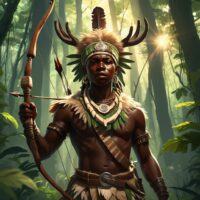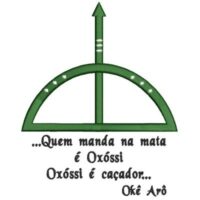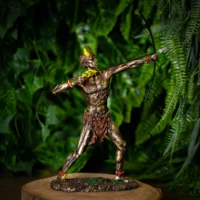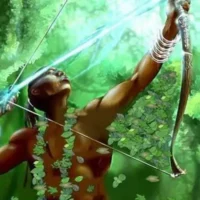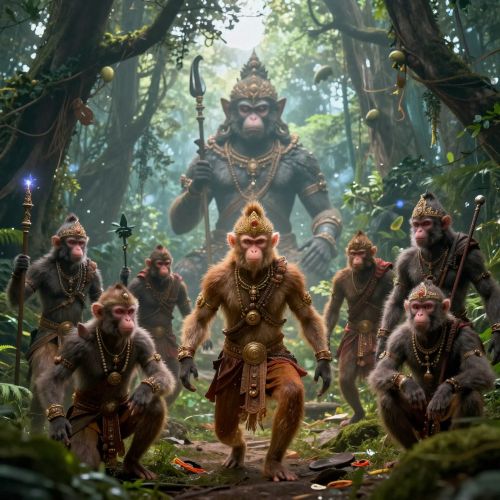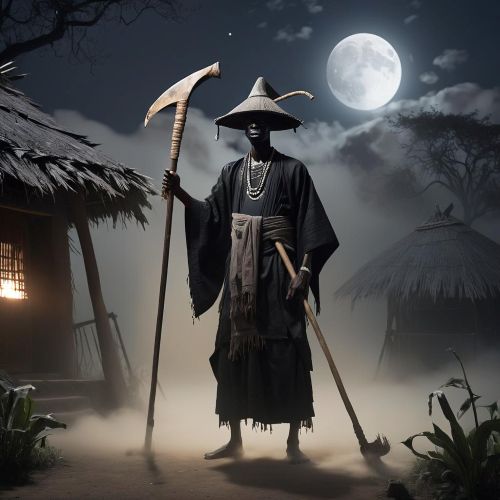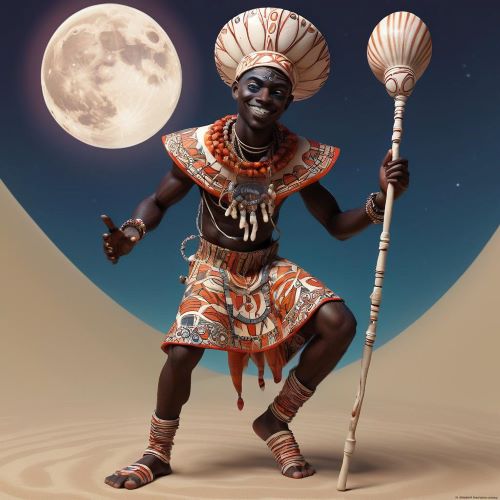Oxossi : God of the Forests
Listen
At a glance
| Description | |
|---|---|
| Origin | Yoruba Mythology |
| Classification | Gods |
| Family Members | Ogun, Elegua (Brothers) |
| Region | Nigeria |
| Associated With | Hunting, Forests, Justice |
Oxossi
Introduction
Oxossi, also spelled Ochosi or Oxóssi, is a revered Orisha in Yoruba mythology and a significant spiritual figure in Afro-Brazilian and Afro-Caribbean religions like Candomblé and Santería. He is known as the Orisha of the hunt, forests, and abundance—an embodiment of resourcefulness, independence, and spiritual clarity. Worshipped primarily on Thursdays, Oxossi is a provider who uses his skills and instincts to ensure survival and prosperity for his devotees. As one of the four warrior Orishas—alongside Eleggua, Ogun, and Osun—Oxossi’s role is to help followers achieve goals once paths are opened and cleared. His presence connects people to nature, justice, and the deeper truths of life, making him a vital figure in both traditional and contemporary spirituality.
Physical Traits
Oxossi is most commonly portrayed as a lithe, youthful hunter armed with a bow and arrow, ready to strike with precision. These tools are not only his weapons but powerful symbols of focus and intent. His physical representation often includes a feathered crown, echoing his connection to birds and the wild. Traditional costumes in his honor feature vibrant combinations of green, blue, or turquoise—colors representing forest life and spiritual insight. During ceremonial dances, his followers mimic tracking movements, galloping like horses or aiming invisible arrows, demonstrating his relentless pursuit of both prey and truth. Additional symbols like mirrors, stag antlers, and fishing hooks highlight his adaptability in harvesting nature’s gifts.
Family
Oxossi’s divine lineage intertwines with other key Orishas, reflecting a spiritual ecosystem of interconnected roles and energies. Often considered the son of Yemaya, the ocean goddess and maternal figure of the Orisha pantheon, Oxossi bridges the realms of sea and forest. In some traditions, he is closely tied to Ogun, the Orisha of iron and warfare, as either a brother or comrade. Their legendary rivalry-turned-alliance speaks to the balance between brute force and strategic finesse. Oxossi is also the father of Logunede, a deity who inherits both hunting skills and aquatic grace from Oxossi and Oxum, the goddess of beauty and rivers. This duality in Logunede’s nature reflects Oxossi’s own balance between survival instincts and spiritual wisdom.
Other names
Across different geographies and belief systems, Oxossi is known by various names that adapt to linguistic and cultural shifts while retaining his essence. In Brazil’s Candomblé, he is called Oxóssi, while in Cuba’s Santería, he appears as Ochosi or Ososi. The Spanish and Portuguese adaptations reflect the influence of colonization and the need to conceal African practices under Christian guises. Consequently, Oxossi was syncretized with saints like Saint Sebastian in Rio de Janeiro and Saint George in Bahia, serving as a protective disguise for worship. These aliases are more than just alternative spellings—they are evidence of his spiritual endurance and cross-cultural legacy.
Powers and Abilities
Oxossi’s abilities are grounded in his mastery of the hunt and the deep spiritual knowledge of the forest. As a skilled tracker and archer, he locates what is needed—be it game, truth, or hidden potential. His power lies not just in physical prowess but in insight, intuition, and timing. Unlike a warrior who charges ahead, Oxossi waits, watches, and acts with deliberate precision. He is a guardian of natural law, punishing those who disturb balance or act unjustly, which is why he’s often associated with justice and law enforcement. His knowledge of plants, animals, and natural remedies gives him shamanic authority, making him a healer and a seer as much as a hunter. Devotees turn to him when seeking direction, wisdom, or clarity, trusting in his ability to find the way through confusion or chaos.
Modern Day Influence
Oxossi’s legacy thrives in modern times through rituals, culture, and art—especially in Brazil, where Afro-Brazilian identity often centers on the orixás. In cities like Salvador and Rio de Janeiro, his feast days are marked with vibrant festivals, music, and dance. These events often include offerings of maize, beans, and fruits, reinforcing his role as a provider. His image appears in everything from street art to fine sculpture, serving as a cultural bridge between ancestral spirituality and contemporary expression.
The African diaspora brought Oxossi into contact with Catholic saints, allowing enslaved Africans to continue their worship under the watchful eyes of colonial powers. This syncretism preserved traditions that now influence diverse spheres—from religious iconography to national folklore. Oxossi has also left his mark on music and literature. Artists like Gilberto Gil, Vinicius de Moraes, and Clara Nunes have referenced him in songs that celebrate Afro-Brazilian heritage, while writers and playwrights draw on his myths to explore themes of justice, resilience, and identity.
Beyond the arts, Oxossi’s principles resonate with modern movements for ecological preservation and social equity. His guardianship over the forest aligns with environmental awareness, while his pursuit of fairness makes him a spiritual ally in struggles for justice. In more recent years, contemporary artists like Oxossi Ayofemi have invoked his name and essence in conceptual works dealing with African diasporic memory and future imaginaries. Through these reinterpretations, Oxossi continues to influence how people think about culture, community, and spirituality.
Related Images
Source
Element Dance. (n.d.). Oxossi. https://www.elementdance.co.uk/Orixas/Oxossi.html
Soul Brasil Magazine. (2020, October 12). ORIXÁS: THE DIVINE FORCE OF NATURE. https://soulbrasil.com/orixas-divinie-force-nature/
TheCollector. (2024, June 3). Meet The Orishas: 10 Afrobrazilian Gods and Goddesses. https://www.thecollector.com/orishas-afrobrazilian-gods-goddesses/
Church of Candomblé. (2016, July 1). The Orixa Oxossi. https://churchofcandomble.com/the-orixa-oxossi/
The Contemporary Jewish Museum. (2018, July 26). Havruta in Contemporary Art—Oxossi Ayofemi and Risa Wechsler. https://www.thecjm.org/exhibitions/105
Godchecker.com. (2019, May 19). OCHOSI – the Yoruba God of Hunting (Yoruba mythology). https://www.godchecker.com/yoruba-mythology/OCHOSI/
Frequently Asked Questions
What is lorem Ipsum?
I am text block. Click edit button to change this text. Lorem ipsum dolor sit amet, consectetur adipiscing elit. Ut elit tellus, luctus nec ullamcorper mattis, pulvinar dapibus leo.
What is lorem Ipsum?
I am text block. Click edit button to change this text. Lorem ipsum dolor sit amet, consectetur adipiscing elit. Ut elit tellus, luctus nec ullamcorper mattis, pulvinar dapibus leo.
What is lorem Ipsum?
I am text block. Click edit button to change this text. Lorem ipsum dolor sit amet, consectetur adipiscing elit. Ut elit tellus, luctus nec ullamcorper mattis, pulvinar dapibus leo.
What is lorem Ipsum?
I am text block. Click edit button to change this text. Lorem ipsum dolor sit amet, consectetur adipiscing elit. Ut elit tellus, luctus nec ullamcorper mattis, pulvinar dapibus leo.
What is lorem Ipsum?
I am text block. Click edit button to change this text. Lorem ipsum dolor sit amet, consectetur adipiscing elit. Ut elit tellus, luctus nec ullamcorper mattis, pulvinar dapibus leo.


